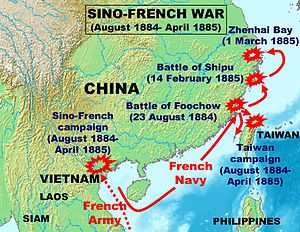
Back الحرب الصينية الفرنسية Arabic Guerra franco-china AST Френско-китайска война Bulgarian Guerra sinofrancesa Catalan Čínsko-francouzská válka Czech Fransk-kinesiske krig Danish Chinesisch-Französischer Krieg German Guerra franco-china Spanish Hiina-Prantsuse sõda Estonian Kiinan–Ranskan sota Finnish
| Sino-French War | |||||||||
|---|---|---|---|---|---|---|---|---|---|
| Part of the French conquest of Vietnam and the Tonkin campaign | |||||||||
 Operations of the Sino-French War | |||||||||
| |||||||||
| Belligerents | |||||||||
|
| |||||||||
| Commanders and leaders | |||||||||
| Strength | |||||||||
| 15,000–20,000 soldiers | 25,000–35,000 soldiers | ||||||||
| Casualties and losses | |||||||||
The Sino-French War,[a] also known as the Tonkin War,[3] was a limited conflict fought from August 1884 to April 1885 between the French Third Republic and Qing China for influence in Vietnam. There was no declaration of war.
The Chinese armies performed better than in their other nineteenth-century wars. Although French forces emerged victorious from most engagements, the Chinese scored noteworthy successes on land,[4] notably forcing the French to hastily withdraw from occupied Lạng Sơn in the late stages of the war, thus regaining control of the town and its surroundings.[5] However, a lack of foreign support, French naval supremacy, and northern threats posed by Russia and Japan forced China to enter negotiations.[6][7][8]
China ceded to France its sphere of influence over Northern and Central Vietnam, which respectively became the protectorates of Tonkin and Annam. Both sides ratified the Treaty of Tientsin[9] and no diplomatic gain was reaped by either nation.[10] On another note, the war strengthened the dominance of Empress Dowager Cixi over the Chinese government but France securing its strategic objective did not prevent the collapse of French Prime Minister Jules Ferry's government for whom the Tonkin Affair was ignominious.
- ^ Clodfelter 2017, p. 239.
- ^ a b c Clodfelter 2017, pp. 238–239.
- ^ See Anonymous, "Named To Be Rear Admiral: Eventful and Varied Career of 'Sailor Joe' Skerrett," The New York Times, April 19, 1894.
- ^ Elleman 2001, p. 87.
- ^ Elleman 2001, pp. 87, 90.
- ^ Elliott 2002, p. 194.
- ^ Elleman 2001, p. 90.
- ^ Tseng 2016, p. 21.
- ^ Twitchett, Cambridge History of China, xi. 251; Chere 1988, pp. 188–90
- ^ Eastman 1967, p. 201.
Cite error: There are <ref group=lower-alpha> tags or {{efn}} templates on this page, but the references will not show without a {{reflist|group=lower-alpha}} template or {{notelist}} template (see the help page).